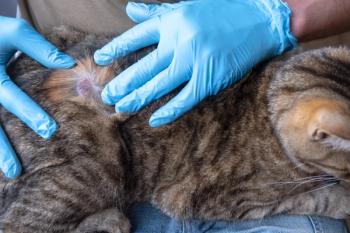
The changing veterinary drug model
Increasing pet owner options about where to obtain medications means veterinarians must adjust, experts say.
There are forces chipping away at the once-exclusive veterinary drug channel. With FidoPharm's recent announcement that it is unveiling a prescription-only generic heartworm medication available (at least initially) only through Walmart pharmacies, some say it's the next step in a fast-changing veterinary drug distribution model.
Well-known consultant, veterinarian and national author and speaker Dr. James F. Wilson of Priority Veterinary Management Consultants explains, "This is just another part of the ongoing commoditization of veterinary medicine." This commoditization is being driven in part by a bad economy and is exacerbated by what consumers and the emerging pet pharmacy competition now believe are unreasonable drug markups by veterinarians, Wilson says. What's missing from the equation is a realization that veterinarians have done this over the years to generate profits from these products in order to subsidize their costs to deliver optimal, but all too often seriously underpriced, professional services, he says.
According to Dr. Michael Paul of Magpie Consulting and former president of the American Animal Hospital Association (AAHA), big-box retailers have been experimenting with the model of offering prescription pet medications through pharmacies.
If consumers are basing their decision to purchase medications strictly on price, the trend may grow in popularity, Paul says. "My concern is our profession has gone along for years using this model," he says. "Equine practitioners lost their pharmacy revenue years ago. It is now catching up with companion animal medicine. There are challenges. Veterinarians will have to come up with more creative ways to draw clients into their practices. We are going to have to rely on information and education."
When it comes to product sales, convenience offers veterinarians a competitive edge, but they will have to compete on price with big-box retailers if they choose to run a full pharmacy within the practice.
In Washington, the debate among lawmakers may only intensify. Despite lobbying by the American Veterinary Medical Association (AVMA) and other national veterinary organizations, along with unified opposition by all 50 state veterinary medical associations, the Fairness to Pet Owners Act, HR 1406, is expected to move forward.
Introduced in April 2011, the bill has been in committee discussions ever since, but Dr. Doug Mader, past president of the North American Veterinary Conference (NAVC), says it's only a matter of time before the proposal becomes reality. Mader helped organize a panel discussion between veterinarians and PetMeds Express in January over the company's drug distribution and marketing tactics. He says that after some of the language in the bill has been tweaked, passage is imminent and "veterinarians need to look at the writing on the wall."
The bill would require veterinarians to write a prescription whether or not they will dispense the product, provide a written disclosure notifying clients that they may fill prescriptions at the veterinary clinic or at an off-site pharmacy, and verify a prescription electronically or by other means consistent with applicable state law. Under the bill, veterinarians may not require a client to purchase an animal drug from them, charge the client a fee for writing a prescription or require the client to sign any waiver of liability disclaimer should the prescription be inaccurately filled by an off-site pharmacy.
AVMA has argued that it already has a long-standing policy encouraging veterinarians to write prescriptions for clients upon request and that the law would create unnecessary regulatory and administrative burdens on practices.
A letter sent to federal lawmakers in January by AVMA, AAHA, all 50 state VMAs and other national veterinary groups argues that veterinary medicine already supports a client's choice to fill a prescription off-site.
"At the same time, veterinary medicine strongly opposes a federal mandate to provide a written prescription each time a product is prescribed, regardless of whether a client wants to go elsewhere. ... And state laws already govern veterinary prescription writing. In fact, multiple states have laws requiring a veterinarian to honor a client's request for a copy of a prescription," the letter states. "Veterinarians are the only professionals licensed to write a prescription for an animal. Due to a veterinarian's unique education and training, we maintain that veterinarians are also the best-qualified professionals to provide guidance when dispensing prescription products for animals."
The passage of the law and its resulting changes probably won't hit the veterinary profession within the next six months but sometime in the next two years, Paul predicts. But it's not all bad, he says.
"It gets us out of the pharmacy business and it gives pet owners an alternative," Paul says. "The consumer always wins and the consumer will decide what they want and where they get their value."
Pet owners have a limited budget for medications, and Paul says their savings could translate to additional dollars available for veterinary care. The practices that will be hurt the most are those who viewed their medication sales as a profit center, he says.
"People who have handled these products like resale commodities are probably going to get burned pretty badly," he says. "The people who have realized that heartworm control and flea-and-tick control are medications, and have treated them as such, are probably going to be just fine."
Although AVMA and state veterinary associations are fighting the change, Paul says veterinarians are up against some heavy hitters, and the battle has just begun. He believes FidoPharm's heartworm preventive is a first step toward a bigger trend.
"My personal belief is they picked heartworm preventive because in many cases it is a very expensive product and people are looking for cheaper alternatives," Paul says. "They also realize that veterinarians are slow to change their pricing structure, so they have a big opportunity to impact buying habits."
But veterinarians will have a chance to improve their profession in other ways, offering clients things the big-box stores can't.
"I think we have to accept that some people are going to go to these stores. Some people are going to come to us. We have to make sure the ones that come to us continue to come to us. You do that building relationships and pricing fairly," Paul says. "If we manage to make these transactions of greater value to them, they will come to us. There are things they can't get at box stores that they can get from us."
Wilson agrees. The danger, in his opinion, to moving pharmaceuticals out of the veterinary hospital and into retail stores is the loss of communication between the practitioner and the client.
"All parties also have to accept that the drugs aren't the only thing curing pets. It's the ongoing, post-medication relationship clients and patients have with their veterinarians that counts," Wilson says. "All parties have to understand that pets are aging approximately seven times faster than people and thus need more than casual once-a-year or one-incident exams and oversight," Wilson says. "What the consumer-driven, low-cost entities fail to understand is the important role veterinarians play in this critical part of the equation. Like pediatricians, veterinarians treat patients that can't talk. This places ever more importance on follow-up evaluations."
Unfortunately, veterinary consultants have been a big part of the problem, Wilson says. In fact, for years consultants have recommended markups ranging from 2 to 2.5 times the cost of the drug. Veterinarians followed their lead, and in Wilson's opinion, this blind faith in consultants is now "killing the goose that laid the golden egg."
Veterinarians have to respond by lowering drug costs, perhaps offering to beat or match competitors' prices, Wilson says. The not-so-secret competitive advantage for veterinarians is convenience.
Use it, he says, because when prescriptions are filled outside of the veterinary hospital, veterinarians lose valuable information about client compliance that raise questions regarding the drug's effectiveness. Is a drug not working because of a failure of the chosen medication or is it because the prescription was never filled? Was it administered improperly or filled by the pharmacy with a "generic" human drug that has no known or proven efficacy for the animal species for which it was dispensed? If there is a suspected drug reaction, will these new players have veterinary pharmacists on call to deal with veterinary clients? Will they know anything about the species-specific bioavailability of the drug their pharmacy dispensed? After all, it is unlikely that the veterinarians who prescribed the drugs will have any knowledge about what product was actually sold by these new players. These are questions veterinarians will have a hard time answering when drugs are obtained and dispensed outside their practices.
"What we need to understand here is that the veterinary practice as the pharmacy is going to change, and we don't have complete control," Wilson says. "That means we have to get the new players in this field to accept and inform their customers that veterinary follow-up care is equally or more valuable than the inexpensive drug they just sold to one of our clients."
Newsletter
From exam room tips to practice management insights, get trusted veterinary news delivered straight to your inbox—subscribe to dvm360.






